
30 Mar Function vs aesthetic
Function vs aesthetic is a war that is fought within all creative and visual outlets from art, design, film, architecture, food, fashion… the list goes on! In the world of ceramics, each artist has a different opinion regarding the subject, typically because we all have a different vision, style and belief when it comes to this wonderful art form. It can be argued that many thousands of years ago, when the first pots were thrown and then fired, ceramics were born with a function and a purpose, and a very important one. Ceramics were (and still are) one of the most efficient and sustainable ways to solve daily problems; from storing plants to give us fresh oxygen, to cooking and storing our food, as well as furnishing our bathrooms with sinks, toilets and tiles. It would be difficult to find a home that does not use any ceramic item.
Every artist, at some point, has to make decisions about the function vs aesthetic ratio of their ceramic project, the more we sketch, experiment and challenge ourselves, the quicker we find our unique recipe of function vs aesthetic. The 137° Ceramic Art Studio offers ongoing weekly courses to practise wheel throwing, hand building and decorating skills. Visit our calendar to find out more.
Why choose function over aesthetic?
All function pottery is designed first and foremost with its mission in mind. Vessels and vases are designed to hold water and material without falling over, whilst a soap dish is designed to let some water run through. The wonderful thing about ceramics is its resilience to external materials, like dust or food, however its weakness is that it can break, smash, crack and chip if there is enough force against it. Ceramics can withstand most things, which is why it is trusted with an important function.
Ceramics are a naturally sustainable material, recycling the material of clay is far more environmentally friendly than manufacturing plastics that are damaging in so many ways. With each and every ceramic item that is made, we are choosing to avoid unnatural materials. Therefore, the very nature of this material is functional.
Many ceramicists start their pottery journey with making items for their home, because the idea of making a cup, or a bowl is an attractive first project as we know we will get much use out of it. Having a goal or a mission for each project makes ceramic design easier in a way, it forces the ceramicist to think about balance, ergonomics, weight and size, and ultimately, it comes down to the comfort and ease of using that object. Some ceramicists avoid dabbling in non-functional ceramics, they are function-oriented and value the purpose of an object over anything else. Furthermore, artists who make functional items for their home always save money on the necessities. This mission of creating what we actually need allows us to treasure our objects more, they teach us to be gentle and more caring as we protect ceramics’ fragility. There is an overwhelming joy and sense of independence in using self-handmade products, not to mention the personal connection and memories that are held within each item.
Artesania Catalunya on Carrer des Banys Nous, in the Gothic Quarter, features many functional and decorative ceramics, including other crafts such as jewellery and fashion. It is a wonderful place to stumble upon, and is excellent for inspiration! You can find out more here.
Why choose aesthetic over function?
Aesthetic, decorative or ‘sculptural’ works are born without a problem solving mission in mind. Instead, they serve a very different purpose which is more personal to each individual, it becomes a subjective art form that can generate many different opinions. Aesthetic pieces are not reviewed in terms of ‘does this object ‘work’ or not?’, instead, we focus on the mood and atmosphere that each object creates, and how well it fits our personal taste.
Whilst we have a more obvious effect on functional pieces (by constantly using them), aesthetic ceramics have more of an effect on us. They are the objects in control; the many surfaces, textures, colours and forms all remind us of our experiences, memories, senses. Aesthetic and sculptural ceramics speak a more hidden language that can be captivating and highly mysterious.
When we create a sculpture without a function in mind, we have total freedom to play and experiment with many options from colour, shape and size. By saying this object needn’t achieve any functional purpose, it often lives on to achieve something greater – art. The term ‘Art for Art’s sake’ expresses the philosophy that art shouldn’t be valued against any moral, political, or social purpose. Sometimes, by giving an object a specific function, we are limiting its capabilities and ignoring its versatile nature.
One could say that having multiple empty vases or bowls in your home is pointless. Empty vessels serve no purpose, yet when these objects are separated from any function, they still hold an immense amount of beauty in its form. These aesthetic pieces allow us to really appreciate the object for what it is, sparking feelings and emotions that otherwise weren’t there before.
For many artists, the meaning or essence of a project is what drives the design and the aesthetic look. The material is chosen to suit that essence and feel of the project. For example, terracotta possesses more of an earthy, natural feel, its rawness is very grounding and primitive, yet, a clay like porcelain possesses a sense of luxury, quality and exquisite beauty. Depending on the deeper meaning of a sculptural or functional project, different clays, can be chosen to enhance that conceptual idea.
The Museu Frederic Marès next to the Cathedral in Barcelona is a vast collection of sculptors, including an extensive Hispanic sculpture collection. This excellent museum is a beautiful day out for anyone interested in sculptural art. Visit their website for more info.
Many artists believe that when we ignore the function vs aesthetic battle, and embrace both of these elements, then we can create objects that not only serve a purpose, but also pleases the eye and contributes to the style and mood of our home. When beauty and function meet, our experience of using that object grows more beautiful day by day, our favourite mug, or soap dish, becomes special and sentimental, not to mention, irreplaceable.
Written by Freya Saleh




